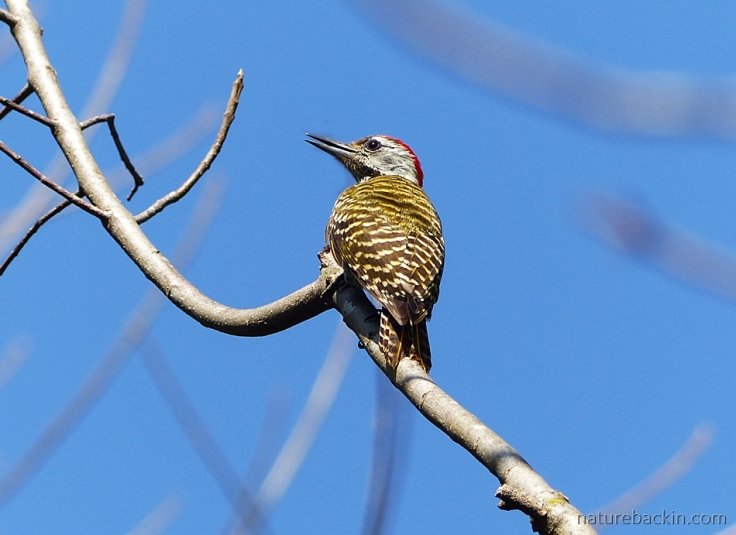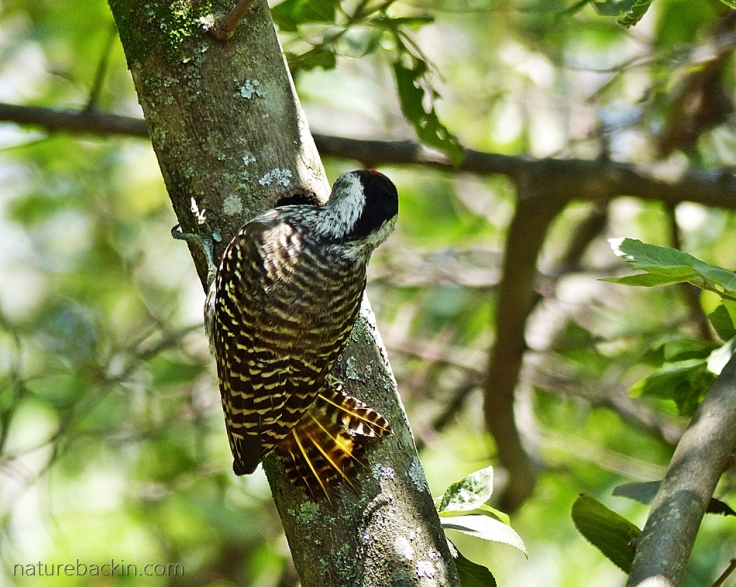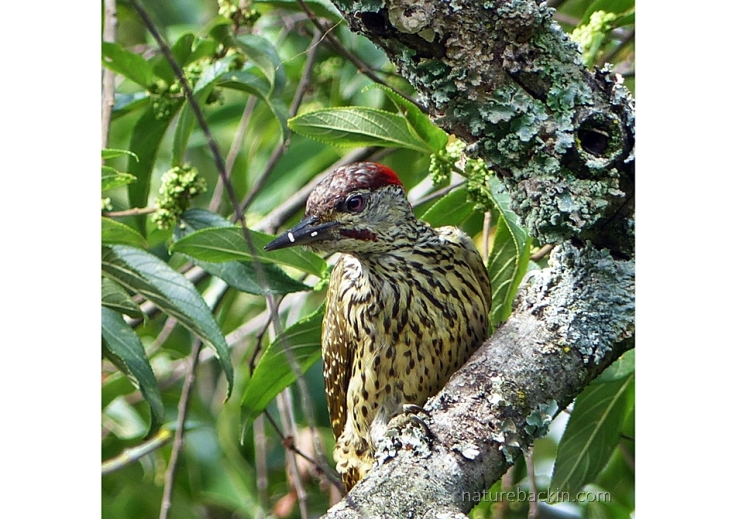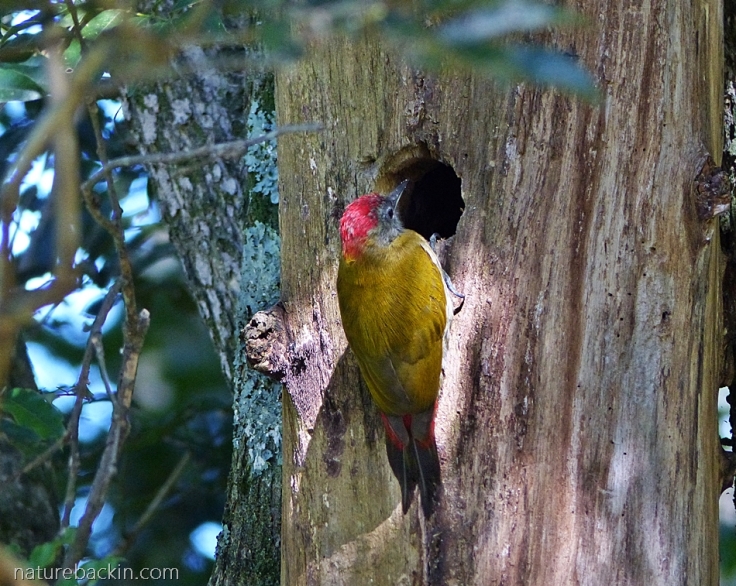We often hear woodpeckers tap-tap-tapping on wood as they search for food in the trees in our suburb most of the year round. They are also quite vocal, but despite all this noisiness they can be difficult to see as they are mostly high up among the branches and foliage of the taller trees.
In addition woodpeckers tend to be wary and often flit off when snooping humans approach on the ground below them. Despite all this, I have managed to photograph the three species of woodpecker that visit our garden.
The smallest is the Cardinal Woodpecker, the commonest and most widespread of African woodpeckers, and because of their calls and tapping I am often aware of a pair foraging together in the garden.

The female Cardinal Woodpecker like the male has a brown forehead, but unlike the male the crown or top of the head is entirely black

The crown of the male Cardinal Woodpecker is red. The male and the female Cardinal Woodpeckers both have distinctive barring rather than spots on their backs
Adult Cardinal Woodpeckers form monogamous breeding pairs and they commonly forage together. They use their barbed tongues to extricate insect larvae and pupae from cavities that they have pecked open in tree trunks and branches. They also glean insects and spiders from thin branches and twigs.

This male has found something to eat while probing a cavity in a branch

He uses his tail for balance

The female is also having foraging success
Both birds in a breeding pair share in excavating a hole for nesting that is usually in a dead branch in a tree. They brood once a year and typically there are two eggs in a clutch. When not breeding they roost at night on their own, in a hole in a tree, usually returning to the same hole each night.
The call of the Cardinal Woodpecker is a repetitive chittering sound, no match for the almost raucous call of the Golden-tailed Woodpecker, which is a single high-pitched screech that can be uttered several times at intervals. Golden-tailed Woodpeckers also forage in trees, and like most woodpeckers they seek out dead branches or dead trees when searching for food. They use their sticky tongues to catch insects, including ants.

A pair of Golden-tailed Woodpeckers probing for insects. The male is at the top left showing his red nape. His crown and forehead are dark with red speckles, whereas the female, also with a red nape, has a black crown and forehead speckled with white

A male Golden-tailed Woodpecker showing his red and speckled-black malar stripe and a back that is spotted rather than barred as in the Cardinal Woodpecker
Like the Cardinal and other woodpeckers they excavate nesting holes in trees. Both adults participate in incubating the eggs and raising the young. As for Cardinal Woodpeckers their nests may be parasitized by Honeyguides.

A male Golden-Tailed Woodpecker with traces of recently found food on his bill – perhaps small larvae or insect eggs
The third species of woodpecker that visits our garden is the Olive Woodpecker, which was the subject of an earlier blog post. The Olive Woodpecker is the only non-speckled woodpecker in the Southern African region.
Of the three species that occur in our garden, this species is larger than the Cardinal Woodpecker, but slightly smaller than the Golden-tailed Woodpecker. To get an idea of the relative sizes, the average length and weight of the small Cardinal Woodpeckers is 15 cm and 30 g; of the Golden-tailed Woodpecker 21 cm and 70 g; and of the Olive Woodpecker 20 cm and 45 g.

I rarely see woodpeckers at the bird bath. However, this male Olive Woodpecker stuck around for a lengthy drink. I took this photo in late winter a few years ago

A male Olive Woodpecker, showing his red crown, investigating a log with a nesting hole that we had made and then hung in a tree with the intention of providing a home for Black-collared Barbets. It was never used for nesting but it is possible it was used for a time for night-time roosting by the Olive Woodpeckers

The female Olive Woodpecker, with a grey head and grey crown, also investigating the nesting hole in a log that we provided. Olive Woodpeckes roost at night in a tree cavity, returning to the same cavity each night and roosting in the same hole together, unlike Cardinal Woodpeckers where each bird roosts in a hole on its own

Although not the clearest of photos, I include this shot because it shows an Olive Woodpecker protruding its tongue. The long tongue is barbed and is used to extract insect larvae and pupae from cracks and from under bark and moss
Although the earlier blog post on the Olive Woodpecker reported on a male woodpecker drumming on a window frame, such drumming activity is not common among Southern African woodpeckers, unlike many North American species of woodpecker, for example.
Roberts (Multimedia edition) reports that in Olive Woodpeckers both sexes “drum infrequently and softly”, Golden-tailed Woodpeckers drum “weakly in slow rolls” lasting about 1.5 seconds, and in Cardinal Woodpeckers “both sexes drum; a brief, soft, resonating grrrru, repeated up to 30 x, using the same point on a dead branch as a resonating board. Baobab Adansonia digitata fruits and metal poles [are] sometimes used for the same purpose”. I have not ever noticed drumming behaviour in any of these species.

A pair of Olive Woodpeckers foraging companionable together in the bark of a Wild Pear (Dombeya rotundifolia) in our garden
Although in the breeding season woodpeckers may spend some time engaged in territorial drumming on suitably resonant materials, mostly they use their bills for pecking wood, chiselling off or lifting bark, and probing lichen or moss as they search for food. Research into how woodpeckers can survive their continuous pecking on hard surfaces without sustaining concussion has revealed anatomical specialisations that work together to protect a bird’s brain while it is engaging in ongoing head-banging in its search for food. This protective system is complex and ongoing research continues to shed new light on the multifaceted mechanisms and relationships that combine to defend the bird from injury.
The woodpecker’s skull structure, bill shape and structure, and the muscles of the neck are adapted to both disperse and absorb the force energy of each blow. Most of the energy is absorbed by the whole body and the force energy absorbed by the brain is mostly in the form of heat. The bird has to rest periodically when pecking to disperse the heat generated.
The skull has specially adapted bones that are flexible and plate-like to absorb and disperse the shock. The flexible hyoid bone is uniquely adapted in woodpeckers so that it connects to muscles in the tongue and throat and then wraps around the back and top of the skull and may act something like a seatbelt to protect the brain. In addition the shape, size and position of the brain as well as the small space for cerebrospinal fluid minimises the potential for brain movement within the skull.
The Cardinal Woodpeckers in our garden are nowhere near as rapid-fire in their pecking as some woodpeckers in the world, but I include the short video (above) of a male Cardinal Woodpecker seeking food in a dead Natal Fig (Ficus natalensis) tree in our garden. I repeat the short sequence in slow motion and end with very short clip taken just before the bird decided to fly away

Sources: Chittenden, Hugh, Davies, Greg & Weiersbye, Ingrid. 2016. Roberts Bird Guide: Illustrating nearly 1,000 Species in Southern Africa (2nd edition). Cape Town: Jacana; Miller, Alison. 2018. “Strategy. Skull protects brain from impact. Woodpecker.” https://asknature.org/strategy/skull-protects-brain-from-impact/; Hauserman, Samantha. “Why don’t woodpeckers get headaches?” Arizona State University. https://askabiologist.asu.edu/plosable/woodpeckers; Orwig, Jessica. 2015. The miraculous reasons woodpeckers can slam their faces into trees all day and never get brain damage. Business Insider October 17. https://www.businessinsider.sg/why-woodpeckers-dont-get-brain-damage-2015-10/; Roberts VII Multimedia PC Edition. 1997-2016 Southern African Birding. For details go to http://www.sabirding.co.za/roberts7/portal.html; Wang.et al. 2013. “Biomechanism of impact resistance in the woodpecker’s head and its application.” Literature review in Science China. Life sciences. 56(8): 715-719. https://www.researchgate.net/publication/248384092_Biomechanism_of_impact_resistance_in_the_woodpecker’s_head_and_its_application; Yirka, Bob. 2014. “Study reveals shock-absorbing ability of woodpecker beaks.” Phys.org. https://phys.org/news/2014-05-reveals-shock-absorbing-ability-woodpecker-beaks.html
Posted by Carol









September 9, 2019 at 4:50 am
pretty pictures and well written…
LikeLiked by 1 person
September 11, 2019 at 6:51 pm
Thanks very much 🙂
LikeLiked by 1 person
July 21, 2019 at 4:29 pm
Woodpeckers are one of my favourite bird families. We have three species in my part of England, although one is very rare and possibly extinct. It is always interesting to learn of their cousins in other parts of the world. Your olive woodpeckers look a little like small versions of our green woodpecker.
LikeLiked by 1 person
July 25, 2019 at 8:27 am
Sad to hear about one species being so rare or possibly extinct. Thanks you for the info – it is interesting to learn about other species in familiar families. I have just looked at some online photos of your green woodpecker and see that like our olive woodpecker it is not speckled or barred on the back. Its distinctive black facial markings, especially on the female, make it look almost fierce 🙂 Interestingly, I see that primarily they eat ants. There is a ground woodpecker in SA but it does not occur in our region.
LikeLiked by 1 person
July 21, 2019 at 6:13 am
Great photos and interesting info about the woodpeckers. We don’t have them here in Hawaii, to my knowledge, but where I used to live, in Washington State, I often saw pileated woodpeckers banging their heads against the trees. I remember someone visiting that area, from Chicago I think, specifically for the chance to see a pileated woodpecker. It’s good not to take for granted those things in our own backyards.
LikeLiked by 1 person
July 21, 2019 at 2:40 pm
I suppose the habitat in Hawaii is not a appropriate for woodpeckers perhaps? From what I have heard about the pileated woodpeckers they do seem to be especially impressive. I so agree about not taking for granted even the familiar, as in their own ways all forms of life are extraordinary and fragile.
LikeLiked by 1 person
July 23, 2019 at 4:49 am
I think it’s more to do with woodpeckers not having been introduced here. There’s plenty of wood and they would probably do fine, but they would have to get here first.
LikeLiked by 1 person
July 25, 2019 at 8:29 am
Thanks Graham. Perhaps it will remain that way. Hawaii seems to have more than its fair share of introduced species!
LikeLiked by 1 person
July 20, 2019 at 7:34 pm
We have greater-spotted woodpeckers come regulalrly to the nut feeders. I love to see them. And in August we might hear the eerie ‘laugh’ of the green woodpecker, digging for ants on the grass. Lovely to see the woodies from another part of the world, Carol!
LikeLiked by 1 person
July 21, 2019 at 2:36 pm
Nice to hear about the woodpeckers that visit where you are. They do seem to have quite a following across the world.
LikeLiked by 1 person
July 20, 2019 at 6:41 am
Lovely blog and photos Carol! We have Cardinal Woodpeckers here, but as you say very elusive… if I sit very still I eventualy see them 🙂
LikeLiked by 1 person
July 21, 2019 at 2:29 pm
Thanks Christeen. It is very rewarding to see them after waiting discreetly 🙂
LikeLiked by 1 person
July 19, 2019 at 7:42 pm
I am always happy when I see woodpeckers in my garden or in the forest. In Germany you often find the Great spotted woodpecker or the Green Woodpecker.
! I didn’t know anything about woodpeckers from South Africa. Especially the Cardinal Woodpecker is such a beauty! And the bird is pretty persistent seeking food! 😊
LikeLiked by 2 people
July 19, 2019 at 8:56 pm
I will look up the two species you mention, thanks. Nice to know that woodpeckers are familiar across much of the globe. Yes they are persistent – they have to do such a lot of work for tiny morsels!
LikeLiked by 1 person
July 19, 2019 at 9:19 am
Great info and images Carol!
LikeLiked by 1 person
July 19, 2019 at 8:54 pm
Thanks very much Pete.
LikeLiked by 1 person
July 19, 2019 at 9:12 am
This is awesome, Carol first of all never knew so much about woodpeckers and such beautiful pictures you have taken. Thanks for this wonderful share.
LikeLiked by 1 person
July 19, 2019 at 8:54 pm
Thanks very much Kamal. It is a pleasure to share what I have found out about such fascinating and beautiful birds.
LikeLike
July 20, 2019 at 4:19 am
Welcome Carol and yes definitely it is nice to be refreshing ourselves with knowledge 🙏🙏🙏🙏
LikeLiked by 1 person
July 19, 2019 at 8:47 am
Very interesting and insightful post – Thank you!
LikeLiked by 1 person
July 19, 2019 at 8:49 pm
Thanks very much. Nice to share what I have found out about the woodpeckers.
LikeLike
July 19, 2019 at 7:09 am
Living right next door and I have heard them often and seen their cavities but never had given thought to the different types. Will now take note.
LikeLiked by 1 person
July 19, 2019 at 8:48 pm
It was their calls that first lead me to differentiate between and then ID the different species. For a long time I didn’t realise the shrieks commonly heard here emanated from a woodpecker (the Golden-tailed as I came to find out). It is lovely to have them around.
LikeLike
July 19, 2019 at 5:52 am
That was so interesting. I’d never previously thought about the effect all that drumming would have on the head: of course! So that, and encountering three different kinds of woodpecker was a great start to the day.
LikeLiked by 2 people
July 19, 2019 at 8:45 pm
The way they manage all that head banging is amazing and the anatomy is fascinating. Glad three woodpeckers made a good start to the day 🙂
LikeLiked by 2 people
July 19, 2019 at 5:32 am
I love hearing woodpeckers in the garden too. Such a comforting sound. Thanks for the great info.
LikeLiked by 1 person
July 19, 2019 at 8:43 pm
Thanks Nikki. I guess the sound is comforting – I had not thought of it that way before 🙂
LikeLike
July 19, 2019 at 4:59 am
It is wonderful that you encounter such a variety of woodpeckers in your garden. Cardinal Woodpeckers visit my garden fairly regularly – but peck rather too high up in branches to be photographed – and I have only once seen an Olive Woodpecker here. Your pictures are great.
LikeLiked by 1 person
July 19, 2019 at 8:42 pm
Thanks Anne. Yes they are difficult to see never mind photograph when they are high up in the trees. Nice to know though that you have two species visiting, even if the Olive seems to visit infrequently.
LikeLike
July 19, 2019 at 4:41 am
There’s just something utterly fascinating about woodpeckers. How wonderful to see the different varieties that you have. I especially enjoyed the Olive Woodpecker since I’ve never encountered a woodpecker in such a lovely shade. I believe nearly all of ours are a combination of black and white, with some red mostly on the head. We have a rather large one called the Pileated Woodpecker. It’s the first one I ever encountered about 25 years ago. I would hear the drumming (very loud), but it took me ages to see the bird. We now have one that seems to like visiting our power pole now and again. What a joy it is to see these birds and you are lucky to have such a great variety of them.
LikeLiked by 1 person
July 19, 2019 at 8:40 pm
I have seen photos and a video of the Pileated Woodpecker and it is a very impressive bird! I think the ones here are tiny by comparison, Woodpeckers are fascinating and the variety of species across most of the globe is remarkable, We are lucky to have 3 species visiting our garden – although they are heard rather more than seen.
LikeLiked by 1 person
July 19, 2019 at 2:34 am
Another insightful post, Carol! thank you so much!
I am sitting here very jealous that you have not one, not two, but three kinds of woodpecker calling your garden home!
LikeLiked by 1 person
July 19, 2019 at 8:30 pm
Thank you Dries. We are very fortunate. Were they not so vocal and tapping so audibly they would be very easy to overlook.
LikeLiked by 1 person
July 18, 2019 at 10:40 pm
Nice, informative post, Carol. I find it amazing that many African birds have cousins elsewhere around the world which have much in common with them. Pangea relations perhaps?
We have 6 commonly seen woodpeckers here in New England– Pileated, Downy, Hairy, & Red-bellied, which are resident, and Flickers and Sapsuckers that migrate.
LikeLiked by 1 person
July 19, 2019 at 8:26 pm
I wonder if most cosmopolitan species date back to Pangea (which I had to look up by the way, being more parochially familiar with Gondwana :))?
I have the impression that generally North American woodpeckers are larger and more versatile drummers than the ones here, In my post I only focused on three species that I have seen in our garden – although there are 9 species in SA including the unusual Ground Woodpecker, and not counting a wryneck. I will look up the species that you mention, thanks, as woodpeckers are such spectacular birds.
LikeLiked by 1 person
July 18, 2019 at 9:06 pm
These are exceptional images, Carol. I find woodpeckers skittish, also. They are tricky to photograph. The Olive woodpecker is especially nice to see, as most of our common species are barred.
LikeLiked by 1 person
July 18, 2019 at 9:18 pm
Thanks so much Sandy. Interesting that you find the woodpeckers skittish where you are too. An added complication of photographing them is the low and/or dappled light within the trees.
The Olive Woodpecker is unusual here too where other woodpeckers are barred or speckled.
LikeLiked by 1 person
July 18, 2019 at 11:45 pm
I find them a joy to watch, even when I can’t get decent shots.
LikeLiked by 1 person
July 19, 2019 at 8:26 pm
Yes they are lovely to watch, and often preferably without a camera 🙂
LikeLiked by 1 person
July 18, 2019 at 8:31 pm
Lovely post, Carol.
I have only seen the Cardinal at our spot and then, only twice in all the time we have lived here.
If we didn’t work from home I doubt I would have ever encountered it.
LikeLiked by 1 person
July 18, 2019 at 9:15 pm
Thanks Ark. I think one has to make a special effort to see woodpeckers as they are generally so concealed. Encountering woodpeckers in your spot is another of the many benefits of working from home 🙂
LikeLiked by 1 person
July 19, 2019 at 9:01 am
One becomes attuned to the multitude of different sounds emanating from the garden.
So, like you, when I recognise what I’m hearing I grab the camera and dash for my office door.
I have a few photos of the Cardinal Woodpecker so at least I have evidence!
LikeLiked by 1 person
July 19, 2019 at 8:52 pm
We are so lucky to be able to down tools when summonsed by even tiny birds 🙂 It is nice when one gets confirmatory photos. The Cardinals are so small and busy and usually partially concealed and in low light and so are really difficult to photograph. I collected the photos for this post over a long period of time. Great displacement activity on my part 🙂
LikeLike